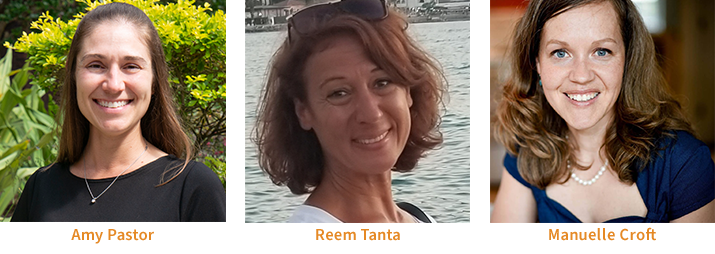At EXP, sustainability is embedded in everything we do. Inspired by national and global ventures, including the United Nations Global Compact and the American Institute of Architects 2030 Challenge, we’ve furthered sustainable initiatives and methods to improve client operations and efficiencies. Across sectors and disciplines, EXP’s global network of professionals are working together to drive results for the built and natural environment. Combining global and local perspectives, we consider broader environmental, social and governance impacts, with a focus on solutions and opportunities for the future.
To learn more about what our leaders are doing, we discussed sustainability with trailblazers at EXP, Director of Commissioning and Sustainability in Florida, Amy Pastor; Human Environment and Sustainability Lead in Canada, Reem Tanta and Project Manager for Sustainable Building in Quebec, Manuelle Croft. These women have been agents for progress and change, and when navigating sustainability challenges and opportunities, our teams and clients rely on their expertise.

In 2020, EXP committed to the United Nations Global Compact Initiative to increase our role in protecting the planet. As part of this initiative, we have an opportunity to focus on the 17 Sustainable Development Goals (SDGs). Which goal is mainly aligned with your expertise?
Amy Pastor: Our group is fortunate to work on a wide range of dynamic and complex projects, spanning across markets. Regardless of our role, whether it’s LEED Certification, WELL Certification, energy modeling, commissioning, design or consulting, I find a holistic approach, with sights set on numerous SDGs, including 3, 7, 9 and 11. This approach is founded on a system of equity, where each aspect is considered before we determine our path to an optimal solution. I believe every project deserves a good look at every possible opportunity to be more sustainable before counting anything out.
Reem Tanta: We can all contribute to the SDGs by simply thinking about those global goals from a local perspective. As the lead for human environment and sustainability services at EXP, SDG 11 – Sustainable Cities and Communities, is one of the primary goals I look at as it aligns with my expertise and passion. As a socio-economist, I also work with clients to integrate other goals into projects including SDG 3, 11 and 17. Using the SDGs as an umbrella, I support our clients in their journeys by identifying their sustainability priorities, setting their targets and commitments and integrating sustainability in their business functions.
Manuelle Croft: My commissioning expertise primarily supports Sustainable Development Goal 13, Climate Action, as it ensures optimal performance of building systems, but through that process, we’re also contributing to the health and well-being of building occupants. Similar to Reem, my Envision certification supports my understanding of how to integrate SDG, 1, 8, 10, 14 and 15 in my work. Working on the Montreal Subway Blue Line Extension Project gave me more insight to the transversal nature of sustainable development measures.
What do you see as rising trends in sustainability right now? How are you adapting to meet these demands?
Amy Pastor: Code-mandated green certifications. In a recent article on LEED + WELL dual certifications, I speak about mandates on green certification. Codes will also mandate better air quality through filtration and increased ventilation, touchless everything and smarter buildings made for resiliency. Why wait until it’s required? Be the early adopter.
Reem Tanta: The global focus on Environment, Social and Governance (ESG) reporting is growing by the day. At EXP, we work proactively with clients, industry associations and practitioner colleagues to share ideas and solutions that can support and grow ESG’s meaningful understanding and implementation. We have been actively engaged with sustainability planners in client organizations who are involved in corporate sustainability reporting and are challenged to understand how different sustainability standards work and which ones are the most relevant to them, e.g. GRI, SDGs, the Carbon Disclosure Project, the Sustainability Accounting Standards Board and International Integrated Reporting Council.
Manuelle Croft: With an evolving need and demand for more sustainable solutions, our team is gaining more experience in certification processes and integrating more innovative approaches. We are more efficient in carrying out sustainable mandates, such as LEED, which is our baseline. As the demand for sustainable solutions grows, our teams are growing their experience with certification processes and integrating more innovative approaches. We’re seeing an increased number of new engineers eager to work in the sustainable development field. The expertise is evolving and it’s everywhere at EXP – in the US with Amy and others, and in Canada with my team and our experts.
Why have you chosen to become so actively involved in sustainability and delivering sustainable solutions for the natural and built environment?
Amy Pastor: I have nieces and nephews and I want them to have a world where they can breathe clean air, drink clean water, have reliable energy sources and when they grow up, continue to move the needle in the right direction to make this Earth a better place.
Reem Tanta: We share one planet that doesn’t recognize administrative and geopolitical boundaries. I have always believed that each human on this planet has a role to play to maintain a healthy living place for all. In doing so, I believe in the notion, “Think globally, act locally” and apply this notion in every project and initiative.
Manuelle Croft: Everything fell into place when I joined EXP in 2012. It has allowed me to work on innovative projects and to act as an auditor for the Green Building Council of Canada. Now, I serve as part of a team that is aimed at sustainable development and we combine our expertise to have positive impacts on the built and natural environment.
As an expert in sustainable development, LEED and sustainable solutions for the built environment, what added value do you bring to clients to improve building efficiency and operational success?
Amy Pastor: My motto – early and often. Too many people wait to consider sustainable solutions. If you have put pen to paper for a design and have not consulted a sustainable expert or an energy modeler, you’ve already lost traction. EXP brings a wealth of knowledge and expertise, including 350+ LEED-certified projects, and best practices to deliver more sustainable and resilient projects.
Reem Tanta: Understanding what each sustainability standard can offer and which one provides the most suitable solutions is the first step. For example, while LEED guides green building design based on occupant comfort and energy efficiency, Envision focuses more on the extended impacts that infrastructure projects can have on communities. As an Envision Sustainability Professional (ENV SP) for EXP, part of the job is to offer solutions to our infrastructure clients outside the building design and more specifically in the building surroundings and community.
Manuelle Croft: This is a great question because processes targeting sustainable outcomes often require an increased commitment by clients. We bring our clients a spectrum of tools to enhance the efficiency of their buildings, with sustainability at the core of our operations. With their equal support for sustainable results, our teams can go above and beyond and benefit their operations, building occupants and communities.
Learn more about EXP’s sustainability services by contacting our experts:
Resources:

